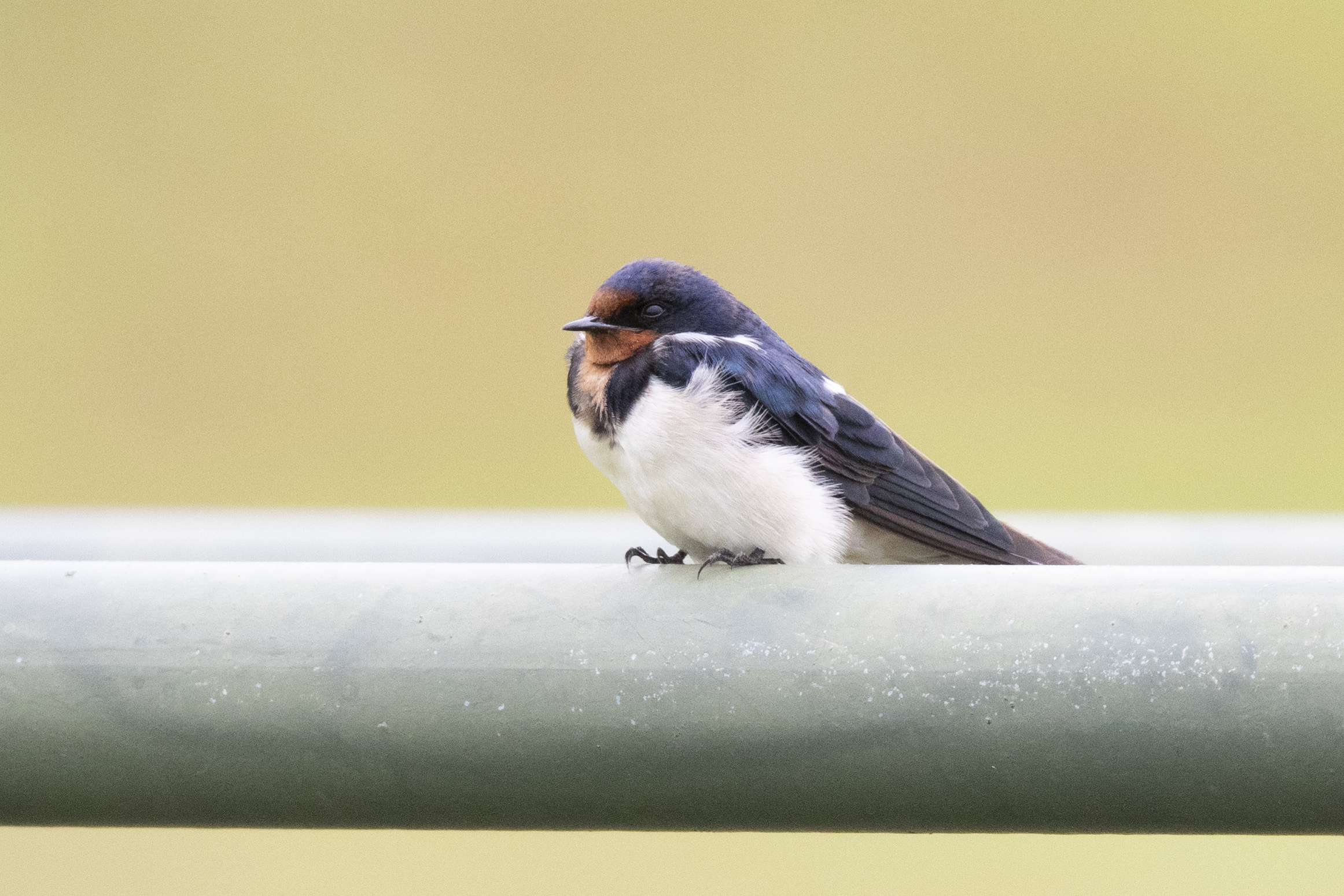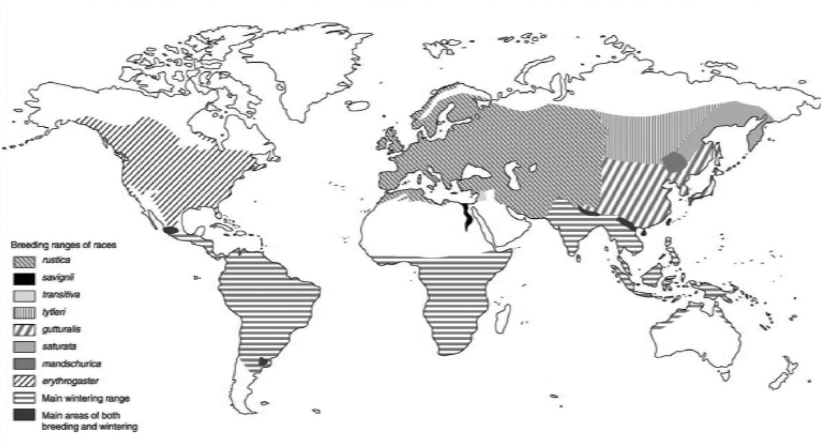TLDR;
- There are several records of Barn Swallows with rufous underparts in Singapore
- Relationships between the different Barn Swallow subspecies are still being explored – we are uncertain of which subspecies the rufous birds seen in Singapore belong to
- In the meantime, please share your sightings if you come across any of these rarer migrants!
Migratory birds are slowly streaming into Singapore as the Northern Hemisphere winter sets in. One of the commonest species that share the local aerospace with the resident swiftlets and Pacific Swallows Hirundo tahitica is the Barn Swallow H. rustica. The Barn Swallows are easily identifiable from their distinct clean white underparts but did you know that rufous Barn Swallows have been seen in Singapore before?
There have so far been at least three documented records of Barn Swallows with rufous underparts in Singapore, one at Punggol Barat on 3 April 2016, one at Neo Tiew on 21 December 2019 and another at Neo Tiew on 20 January 2020 (though possibly the same individual spotted a month earlier).
The usual Barn Swallows that visit Singapore during the wintering months are of the subspecies gutturalis (Chasen, 1923; Gibson-Hill, 1950) with clean white underparts along with a distinct black breast band (Figure 1). It is currently still unclear which subspecies these rufous Barn Swallows belong to, but what the local community can do in the meantime is to make sure that these records are properly documented while researchers continue to study their relationships!

This article will become slightly technical from here onwards, but for those who have an interest in the biology of birds, read on!
Barn Swallow subspecies taxonomy is tricky; different authors have differing opinions on which subspecies are valid and the boundaries of their breeding ranges (Figure 2, Table 1). With regards to the subspecies that occur in Southeast Asia (and consequently Singapore), the International Ornithological Committee (IOC) recognises four subspecies, namely gutturalis, tytleri, mandschurica and saturata, while Birds of the World (BOTW) recognises gutturalis, tytleri and mandschurica too, but treats saturata as part of gutturalis instead. On the other hand, Dor et al. (2010) who has worked on Barn Swallow phylogeny lists two relevant subspecies, gutturalis and tytleri.

Note. Reprinted from The Barn Swallow (p 21), by A. Turner, 2006, A&C Black Publishers Ltd. Copyright 2006 by Angela Turner.

Of the supposed four subspecies that might occur in Singapore, only one is described to have creamy white underparts (gutturalis), with the other three (tytleri, mandschurica and saturata) have some degree of rufous on the underparts (Table 2).

Note. Adapted from The Barn Swallow (p 20), by A. Turner, 2006, A&C Black Publishers Ltd. Copyright 2006 by Angela Turner.
However, on top of the difficulty in distinguishing underpart colours (what is the difference between ochre, rufous and chestnut?), plumage can also vary with individuals and wear (Dickinson and Dekker, 2001). More significantly, there is likely to be interbreeding between different subspecies in intergrade zones within their breeding range (Dickinson and Dekker, 2001; Nazarenko, 2016; Turner, 2006). For instance, there are some interesting swallows that are within range of tytleri and/or where tytleri overlaps with other populations (such as gutturalis) that are not entirely white or rufous, and some examples are listed here: a) western Mongolia, mostly white underparts with rufous tinge; b) central Mongolia, underparts with faint rufous tinge; c) central Mongolia, pale rufous underparts d) northern Mongolia, white underparts with rufous vent. Compare these with birds found further north (that are presumably tytleri based on range) such as this and this that are clearly much more rufous in colour.
As the ornithological community continues to explore the answers to the relationships of the various Asian populations of Barn Swallows in their breeding ranges, the verdict on the “rufous” individuals in Singapore is still open to interpretation. However this doesn’t change the fact that they are quite rare locally, so please do share your sightings if you manage to spot or photograph any!
Disclaimer: The authors of this short article (Dillen and Keita) have not been involved in any of the Barn Swallow studies. We dove into this topic confused and emerged out of it even more confused – please let us know if there are any errors!
References:
Chasen, F. N. (1923). An introduction to the birds of Singapore island. Singapore Naturalist, 2, 87-111.
Dickinson, E. C., & Dekker, R. W. R. J. (2001). Systematic notes on Asian birds. 13. Preliminary review of the Hirundinidae. Zoologische Verhandelingen, 25, 127-144.
Dor, R., Safran, R. J., Sheldon, F. H., Winkler, D. W., & Lovette, I. J. (2010). Phylogeny of the genus Hirundo and the Barn Swallow subspecies complex. Molecular Phylogenetics and Evolution, 56, 409-418.
Gibson-Hill, C.A. (1950). A checklist of the birds of Singapore island. Bulletin of the Raffles Museum, 21, 132-183.
Nazarenko A.A., Pavlenko M.V., Kryukov A.P. (2016). Introgressija genov populjacii Hirundo rustica tytleri v populjaciju H. r. gutturalis na jugo-zapade Ussuriĭskogo kraja (na primere Vladivostoka): otgoloski bylyh i tekushhih istoriko-biogeograficheskih sobytiĭ [Introgression of the genes of the Hirundo rustica tytleri population in the H. r. gutturalis population in the south-west of the Ussuri region (upon the example of Vladivostok): echoes of past and current historical-biogeographical events]. Russkiĭ ornitologicheskiĭ zhurnal, 25, 523-536.
Turner, A. (2006). The barn swallow. T&AD Poyser.
